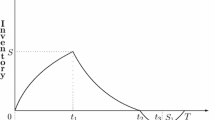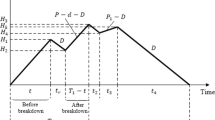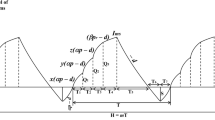Abstract
The constant demand rate is the most common assumption of the basic economic production quantity model, which is not very frequent in practice. In real world situations, demand usually varies with time. With regard to the widespread necessity of power demand pattern, demand is supposed to follow a power law. Another unrealistic assumption is perfect quality of all items. This paper presents a production system with defective items to determine the optimal replenishment quantity, cycle length and backordered size with a power demand rate dependent production rate. We assume that a manufacturer may be faced with three different cases regarding to the date that defective items are drawn from inventory. The set-up, backordering, inspection, and production costs, as well as holding cost of both perfect and imperfect items are accounted in the inventory system. An algorithm is offered to optimize total inventory cost and then numerical analyses are presented to demonstrate the applicability of the proposed models. Finally, some sensitivity analyses and managerial insights are provided.















Similar content being viewed by others
References
Harris F W 1913 How many parts to make at once. The Magazine of Management. 10(2): 135–136. (152)
Taft E W 1918 The most economical production lot. Iron Age 101(18): 1410–1412
Silver E A and Meal H C 1973 A heuristic for selecting lot size quantities for the case of a deterministic time-varying demand rate and discrete opportunities for replenishment. Production and Inventory Management 14(2): 64–74
Donaldson W A 1977 Inventory replenishment policy for a linear trend in demand—An analytical solution. Oper. Res. Q. 28(3): 663–670
Ritchie E 1984 The EOQ for linear increasing demand: A simple optimal solution. J. Oper. Res. Soc. 35(10): 949–952
Bose S, Goswami A and Chaudhuri K S 1995 An EOQ model for deteriorating items with linear time-dependent demand rate and shortages under inflation and time discounting. J. Oper. Res. Soc. 46(6): 771–782
Teng J T 1996 A deterministic inventory replenishment model with a linear trend in demand. Oper. Res. Lett. 19(1): 33–41
Zhao G Q, Yang J and Rand G K 2001 Heuristics for replenishment with linear decreasing demand. Int. J. Prod. Econ. 69(3): 339–345
Lo W Y, Tsai C H and Li R K 2002 Exact solution of inventory replenishment policy for a linear trend in demand–two-equation model. Int. J. Prod. Econ. 76(2): 111–120
Yang J, Zhao G Q and Rand G K 2004 An eclectic approach for replenishment with non-linear decreasing demand. Int. J. Prod. Econ. 92(2): 125–131
Omar M and Yeo I 2009 A model for a production–repair system under a time-varying demand process. Int. J. Prod. Econ. 119(1): 17–23
Maihami R and Kamalabadi I N 2012 Joint pricing and inventory control for non-instantaneous deteriorating items with partial backlogging and time and price dependent demand. Int. J. Prod. Econ. 136(1): 116–122
Pando V, San-José L A, García-Laguna J and Sicilia J 2013 An economic lot-size model with non-linear holding cost hinging on time and quantity. Int. J. Prod. Econ. 145(1): 294–303
Naddor E 1966 Inventory systems. New York: Wiley
Lee W C and Wu J W 2002 An EOQ model for items with Weibull distributed deterioration, shortages and power demand pattern. Int. J. Inf. Manag. Sci. 13(2): 19–34
Dye C Y 2004 A Note on “An EOQ model for items with Weibull distributed deterioration, shortages and power demand pattern”. Int. J. Inf. Manag. Sci. 15: 81–84
Singh T J, Singh S R and Dutt R 2009 An EOQ model for perishable items with power demand and partial backlogging. Int. J. Prod. Econ. 15(1): 65–72
Abdul-Jalbar B, Gutiérrez J M and Sicilia J 2009 A two-echelon inventory/distribution system with power demand pattern and backorders. Int. J. Prod. Econ. 122(2): 519–524
Rajeswari N and Vanjikkodi T 2011 Deteriorating inventory model with power demand and partial backlogging. International Journal of Mathematical Archive (IJMA). 2(9): 1495–1501
Sicilia J, Febles-Acosta J and González-De La Rosa M 2012 Deterministic inventory systems with power demand pattern. Asia-Pacific Journal of Operational Research 29(05): 1250025
Sicilia J, Febles-Acosta J and González-De la Rosa M 2013 Economic order quantity for a power demand pattern system with deteriorating items. Eur. J. Indist. Eng. 7(5): 577–593
Sicilia J, González-De-la-Rosa M, Febles-Acosta J and Alcaide-López-de-Pablo D 2015 Optimal inventory policies for uniform replenishment systems with time-dependent demand. Int. J. Prod. Res. 53(12): 3603–3622
Sicilia J, González-De-la-Rosa M, Febles-Acosta J and Alcaide-López-de-Pablo D 2014 An inventory model for deteriorating items with shortages and time-varying demand. Int. J. Prod. Econ. 155: 155–162
Sicilia J, González-De-la-Rosa M, Febles-Acosta J and Alcaide-López-de-Pablo D 2014 Optimal policy for an inventory system with power demand, backlogged shortages and production rate proportional to demand rate. Int. J. Prod. Econ. 155: 163–171
San-José L A, Sicilia J, González-De-la-Rosa M and Febles-Acosta J 2017 Optimal inventory policy under power demand pattern and partial backlogging. Appl. Math. Model. 46: 618–630
Keshavarzfard R, Makui A and Tavakkoli-Moghaddam R 2019 A multi-product pricing and inventory model with production rate proportional to power demand rate. Advances in Production Engineering and Management 14(1): 112–124
Shih W 1980 Optimal inventory policies when stockouts result from defective products. Int. J. Prod. Res. 18(6): 677–686
Schwaller R L 1988 EOQ under inspection costs. Production and Inventory Management Journal 29(3): 22
Salameh M K and Jaber M Y 2000 Economic production quantity model for items with imperfect quality. Int. J. Prod. Econ. 64(1): 59–64
Hayek P A and Salameh M K 2001 Production lot sizing with the reworking of imperfect quality items produced. Production Planning and Control. 12(6): 584–590
Goyal S K, Huang C K and Chen K C 2003 A simple integrated production policy of an imperfect item for vendor and buyer. Production Planning and Control 14(7): 596–602
Chiu Y P 2003 Determining the optimal lot size for the finite production model with random defective rate, the rework process, and backlogging. Engineering Optimization 35(4): 427–437
Jamal A M M, Sarker B R and Mondal S 2004 Optimal manufacturing batch size with rework process at a single-stage production system. Comput. Ind. Eng. 47(1): 77–89
Ojha D, Sarker B R and Biswas P 2007 An optimal batch size for an imperfect production system with quality assurance and rework. Int. J. Prod. Res. 45(14): 3191–3214
Cárdenas-Barrón L E 2009 Economic production quantity with rework process at a single-stage manufacturing system with planned backorders. Comput. Ind. Eng. 57(3): 1105–1113
Taleizadeh A, Najafi A A and Akhavan Niaki S T 2010 Economic production quantity model with scrapped items and limited production capacity. Scientia Iranica-Transaction E: Industrial Engineering 17(1): 58–69
Taleizadeh A A, Cárdenas-Barrón L E, Biabani J and Nikousokhan R 2012 Multi products single machine EPQ model with immediate rework process. International Journal of Industrial Engineering Computations 3(2): 93–102
Ouyang L Y, Chen L Y and Yang C T 2013 Impacts of collaborative investment and inspection policies on the integrated inventory model with defective items. Int. J. Prod. Res. 51(19): 5789–5802
Taleizadeh A A, Jalali-Naini S G, Wee H M and Kuo T C 2013 An imperfect multi-product production system with rework. Scientia Iranica-Transaction E: Industrial Engineering. 20(3): 811–823
Taleizadeh A A, Cárdenas-Barrón L E and Mohammadi B 2014 A deterministic multi product single machine EPQ model with backordering, scraped products, rework and interruption in manufacturing process. Int. J. Prod. Econ. 150: 9–27
Jaber M Y, Zanoni S and Zavanella L E 2014 Economic order quantity models for imperfect items with buy and repair options. Int. J. Prod. Econ. 155: 126–131
Taleizadeh A A, Noori-daryan M and Tavakkoli-Moghaddam R 2015 Pricing and ordering decisions in a supply chain with imperfect quality items and inspection under buyback of defective items. Int. J. Prod. Res. 53(15): 4553–4582
Taleizadeh A A and Noori-Daryan M 2015 Pricing, Manufacturing and Inventory Policies for Raw Material in a Three-Level Supply Chain, International Journal of Systems Science 47(4): 919–931
Treviño-Garza G, Castillo-Villar K K and Cárdenas-Barrón L E 2015 Joint determination of the lot size and number of shipments for a family of integrated vendor–buyer systems considering defective products. Int. J. Syst. Sci. 46(9): 1705–1716
Taleizadeh A A and Wee H M 2015 Manufacturing system with immediate rework and partial backordering. International Journal of Advanced Operations Management 7(1): 41–62
Tai A H 2015 An EOQ model for imperfect quality items with multiple quality characteristic screening and shortage backordering. Eur. J. Indust. Eng. 9(2): 261–276
Taleizadeh A A, Kalantari S S and Cárdenas-Barrón L E 2015b Determining optimal price, replenishment lot size and number of shipments for an EPQ model with rework and multiple shipments. J. Ind. Manag. Optim. 11(4): 1059–1071
Hsu L F and Hsu J T 2016 Economic production quantity (EPQ) models under an imperfect production process with shortages backordered. Int. J. Syst. Sci. 47(4): 852–867
Taleizadeh A A and Moshtagh M S 2019 A consignment stock scheme for closed loop supply chain with imperfect manufacturing processes, lost sales, and quality dependent return: Multi Levels Structure. Int. J. Prod. Econ.
Stoer J and Bulirsch R 2013 Introduction to numerical analysis (Vol. 12). Springer Science & Business Media, Germany
Taleizadeh A A, Wee H M and Jolai F 2013 Revisiting fuzzy rough economic order quantity model for deteriorating items considering quantity discount and prepayment. Mathematical and Computer Modeling 57 (5-6): 1466–1479
Tat R, Taleizadeh A A and Esmaeili M 2015 Developing EOQ model with non-instantaneous deteriorating items in vendor-managed inventory (VMI) system. International Journal of Systems Science 46(7): 1257–1268
Taleizadeh A A, Kalantary S S and Cárdenas-Barrón L E 2015 Determining optimal price, replenishment lot size and number of shipment for an EPQ model with rework and multiple shipments. Journal of Industrial and Management Optimization 11(4): 1059–1071
Author information
Authors and Affiliations
Corresponding author
Appendix A
Appendix A
Proposition 1
Equal \( \left( {1 - x} \right)^{n} - \frac{{x^{n} }}{{\left( {\left( {1 -\uplambda} \right)\alpha - 1} \right)^{n} }} - \frac{{C_{b} }}{{C_{b} + C_{h} }} = 0 \) has a unique solution \( x^{*} \)on \( \left( {0,\frac{{\left( {\left( {1 -\uplambda} \right)\alpha - 1} \right)}}{{\left( {1 -\uplambda} \right)\alpha }}} \right) \).
Proof
Suppose that f(x) is a real function on [0,1] defined by:
f(x) is continuous, strictly decreasing differentiable on the interval (0,1) because (notice that according to assumption 9, \( \left( {1 - \lambda } \right)\alpha - 1 > 0 \)):
Also, we have \( f\left( 0 \right) = \frac{{C_{h} }}{{C_{b} + C_{h} }} > 0 \) and \( f\left( {\frac{{\left( {\left( {1 -\uplambda} \right)\alpha - 1} \right)}}{{\left( {1 -\uplambda} \right)\alpha }}} \right) = - \frac{{C_{b} }}{{C_{b} + C_{h} }} < 0 \). So, using the intermediate value theory, a point \( x^{*} \) exists in the interval \( \left( {0,\frac{{\left( {\left( {1 -\uplambda} \right)\alpha - 1} \right)}}{{\left( {1 -\uplambda} \right)\alpha }}} \right) \), where \( y(x^{*} ) = 0 \). Finally, because of that the function is decreasing on (0,1), the point \( x^{*} \) is unique.
Proposition 2
The total cost function \( TC_{I} \left( {s,T} \right) \) is strictly convex.
Proof
Using the second order derivatives of \( TC_{I} \left( {s,T} \right) \) respect to decision variables, we have:
And the Hessian of the function \( TC_{I} \left( {s,T} \right) \) is given by:
Eqs. (c) to (g) are positive, because in the region \( \frac{{ - \left( {\left( {1 - \lambda } \right)\alpha - 1} \right)}}{{\left( {1 - \lambda } \right)\alpha }}rT \le s \le 0 \), we always have \( s + rT > 0 \). Therefore, the function \( TC_{I} \left( {s,T} \right) \) is strictly convex.
Rights and permissions
About this article
Cite this article
Keshavarzfard, R., Makui, A., Tavakkoli-Moghaddam, R. et al. Optimization of imperfect economic manufacturing models with a power demand rate dependent production rate. Sādhanā 44, 206 (2019). https://doi.org/10.1007/s12046-019-1171-4
Received:
Revised:
Accepted:
Published:
DOI: https://doi.org/10.1007/s12046-019-1171-4




